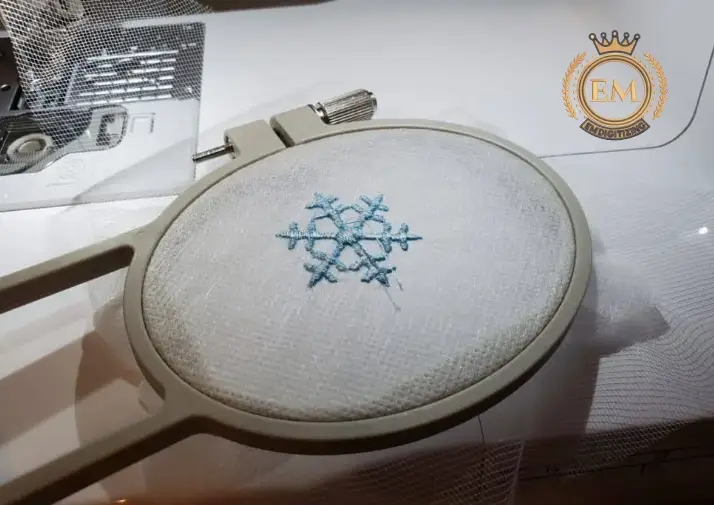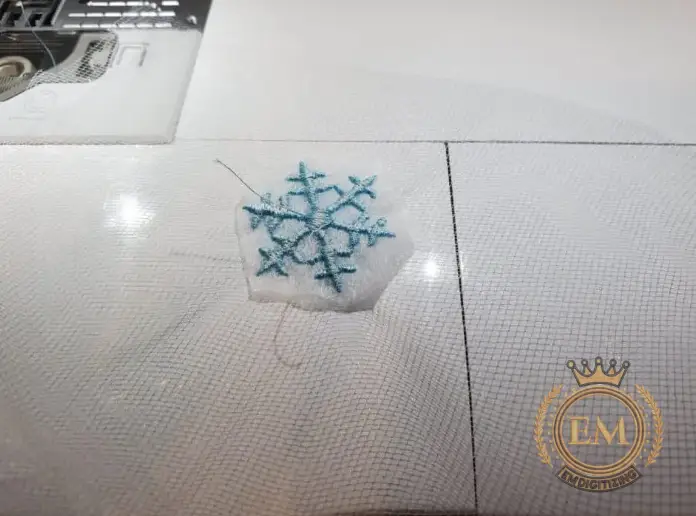
Tulle is a type of material that I don’;Non usarlo molto spesso. My girls are past the age of tutus and princesses so I don’;Non ci penso davvero. Ma il tulle in realtà è un adattabile materiale per ricamo a macchina. Può agire come a stabilizzatore e valorizzare un capo ricamato o applicato. Oppure puoi ricamare sul tulle stesso. Così, here’;Ecco come ricamare sul tulle e alcuni esempi di come puoi utilizzare il tulle nel tuo ricamo a macchina progetti.
Cos'è Tulle?
Mai sentito parlare di tulle? Questo è il materiale utilizzato per realizzare i tutù di balletto. In realtà è un tipo di rete anche se il tulle ha fori più grandi della rete. Puoi acquistare lo strumento in cantiere o in qualsiasi negozio di tessuti oppure online su una bobina larga 6″.
Servizi di digitalizzazione del ricamo
Perché vorresti ricamare su Tulle??
Il tulle ha una qualità eccezionale che lo rende una scelta popolare per qualsiasi cosa, dagli abiti da principessa agli abiti da sposa e da ballo. Il ricamo sul tulle sembra lussuoso, motivo per cui di solito lo vedi negli abiti formali e negli abiti da sera.
Lo strumento è anche rigido, così puoi piegarlo insieme per creare volume. Questo è il motivo per cui i tutù sono così imperfetti. Spesso gli abiti sono realizzati con il tulle come sottostrato per dare loro un po' più di grinta.
Lo strumento è anche semitrasparente, quindi è spesso stratificato con altri materiali. Quando lo metti sopra un altro indumento, puoi vedere l'indumento sotto. Certo, se vuoi fare qualcosa di veramente innovativo, puoi applicare o ricamare strategicamente aree del tulle per coprire zone di pelle, poi lascia trasparire la pelle attraverso il tulle.
Perché è difficile ricamare su Tulle?
Lo strumento rappresenta una sfida per il ricamo a macchina perché il materiale è così leggero e può strapparsi facilmente. It’;s also very porous so it doesn’;t give the embroidery much to “;cut”;. Così, affinché i punti rimangano, è necessario stabilizzare lo strumento con un materiale che possa offrire stabilità mentre cuci, then disappear when you’;finito.
Anche il tulle tende ad arricciarsi, quindi è necessario mantenerlo in posizione mentre ricami sul tulle. Fissarlo in posizione non è un'opzione poiché il materiale è troppo poroso per trattenere i perni. Anche, i perni possono causarne la rottura.
Materiali utilizzati per ricamare su tulle
Ecco alcuni materiali utilizzati per ricamare su Tulle.
- Telaio da ricamo, macchina da ricamo, e forbici
- Troll
- Stabilizzatore: Uno stabilizzatore lavabile (non una copertura solubile in acqua che sia appiccicosa e simile a una pellicola).
- Ago: Ho usato un 75/11 Ago da ricamo Schmitz.
- Filo: Ho usato 40 filo da ricamo in poliestere per il filo superiore e preavvolto bianco 60 peso del filo per la bobina. Certo, vuoi abbinare la bobina e i fili superiori.)
Il miglior stabilizzatore per Tulle
Poiché il tulle è trasparente, il miglior stabilizzatore utilizzato per ricamare sul tulle è uno stabilizzatore lavabile.
Usare uno stabilizzatore a rete tagliato o invisibile è una cattiva idea perché lo stabilizzatore sarà ancora attaccato al tulle dopo il ricamo. E quando manca lo stabilizzatore a strappo, it won’;Non funziona bene perché strapparlo può danneggiare il tessuto delicato e i punti.
Scegliere il tulle giusto durante il ricamo su tulle
Il tulle è un delicato, puro, tessuto fluido a rete con piccoli fori. È trasparente ed è disponibile in una miriade di colori e può essere opaco, lucido, lucido, e altro ancora. Lo puoi trovare in tutto, dai soffici vestitini per bambini e tutù agli eleganti abiti da sera e veli da sposa.
Il tulle è realizzato con diversi materiali come il nylon, poliestere, o seta. Materiali diversi conferiscono al tulle proprietà diverse e ricamare sul tulle è più facile o più difficile. Il tulle di nylon è il tipo di tulle più comune ed è quello che ho usato per questo tutorial di ricamo per principianti.
Se vuoi provare a ricamare a macchina sul tulle per la prima volta, I’;Ti consiglio di iniziare con un tulle meno delicato con fori più piccoli e poi di espandersi in varietà più lussuose. Più delicato, i modelli lussuosi sono particolarmente belli se vuoi ricamare su tulle.
Consigli per ricamare su tulle
- Il disegno deve essere sufficientemente denso da essere visibile attraverso il tulle, ma non così denso da strappare lo stabilizzatore o ferire il tulle.. Ad esempio, i disegni con solo punti continui non funzioneranno perché i punti avranno difficoltà a trattenere le fibre dell'utensile ampiamente distanziate. Un disegno di punto di riempimento troppo grande e denso, d'altro canto, può potenzialmente danneggiare le fibre del tulle e causare arricciature sul design o strappi dello stabilizzatore.
- Usato la dimensione del telaio più piccola adatta al tuo disegno del ricamo. Quando diventavo pigra e ricamavo più di un fiocco di neve alla volta, they didn’;Non sono uscito così bene come ho fatto con un fiocco di neve nel mio cerchio più piccolo.
- Se il tuo strumento è molto delicato, aggiungi uno stabilizzatore. Prossimo, spruzzare un leggero strato di adesivo temporaneo per tessuti come Odif 505 sul tulle e pressalo sullo stabilizzatore nel telaio. Pin solo come ultima risorsa. Preferisco l'intelaiatura perché l'attrezzo raccoglie di più quando galleggia che quando è agganciato. E, l'adesivo era troppo disordinato per essere spruzzato su un tessuto forato!
- Come regola generale, durante la risoluzione dei problemi di ricamo su tessuti nuovi, rallentare la velocità di cucitura. I miei progetti vanno meglio così, e posso individuare gli errori prima che arrivino troppo lontano!
How to Embroider on Tulle –; Tutorial veloce
Se hai bisogno di contrassegnare il tuo tulle per lo spazio di progettazione, considera l'utilizzo di una penna per tessuti idrosolubile o anche di un semplice adesivo spaziale ricamato.
Adesso, avvolgi lo stabilizzatore e lo strumento Wash-A nel telaio da ricamo. Ricordatevi di utilizzare il telaio più piccolo possibile, e intelaiare lo stabilizzatore e il tessuto molto strettamente senza distorcere il tulle.
Il mio primo tentativo di ricamo a macchina su tulle è andato molto meglio di quanto sperassi perché le cose nel telaio erano troppo larghe.

Prossimo, posiziona con cura il telaio nella macchina da ricamo, e seleziona il tuo disegno del ricamo. Orientalo correttamente e assicurati di ottenere il filo e l'ago corretti.
Impostare la macchina su una velocità di oscillazione lenta, e premere Inizio! Keep an eye on the machine to make sure you don’;Non ci saranno strappi o lacerazioni.
Quando fatto, tagliare eventuali fili saltati. Di seguito è riportata la parte anteriore del mio design! Che bello, Giusto?

Poi, here’;è il retro. Immaginatelo 15 volte su una mantella di tulle.

Dopo aver ammirato il tuo filo da ricamo, rimuoverlo delicatamente insieme allo stabilizzatore dal telaio.
Quindi, agganciare lo stabilizzatore a destra vicino al disegno. Questo renderà più facile il lavaggio.

Infine, rimuovi lo stabilizzatore Wash-A immergendo lo strumento in acqua. Potrebbero essere necessari diversi minuti per dissolversi. Fai attenzione se decidi di mettere il disegno sotto un getto d'acqua. Ciò può interrompere i tuoi punti delicati!
Dopo che lo stabilizzatore si è sciolto tutto, lasciare asciugare lo strumento, and then that’;sedersi!

Conclusione
Spero che questo tutorial ti abbia insegnato alcuni consigli su come ricamare sul tulle e ti abbia aperto la mente a nuove possibilità creative!
Spruzzare un pezzo di stabilizzatore idrosolubile con un po' di adesivo spray temporaneo, e liscia il tulle superiore. Attacca saldamente i due strati. Ricamo di disegno. Vicino al ricamo dello stabilizzatore, facendo attenzione a non tagliare il tulle.
Il tessuto in tulle è davvero sottile, elastico, e alquanto delicato. Quindi naturalmente, it’;È difficile da ricamare, ma il risultato finale è davvero gratificante! When you’;ci stiamo lavorando, make sure you don’;Non tirarlo troppo nel telaio. Vuoi che il tessuto venga insegnato, ma non distorcere la trama naturale del tessuto.
La maggior parte dei tulle di nylon non funziona bene sotto tensione, either –; si strappa nel cerchio, o quando si stringe il telaio. Il tulle di cotone è un tessuto a rete resistente. Questo è un bellissimo tessuto. Ed è un tessuto di fondo adatto per le tecniche di ricamo a mano e per i lavori di pizzo a macchina.
Ma il tulle è in realtà un materiale versatile per il ricamo a macchina. Può fungere da stabilizzatore e ingrandire un oggetto ricamato o applicato.
Il tulle è un tessuto scivoloso che può essere difficile da cucire la prima volta. Potresti voler fissare gli strati di tulle con spille o spille da balia e rimuoverli mentre cuci. Prima di iniziare a cucire, it’;s a good idea to test your stitches on a scrap of tulle fabric that you’;lavorerò con.
